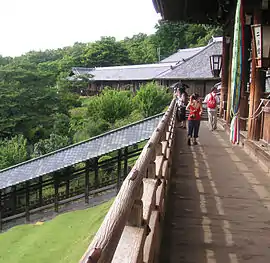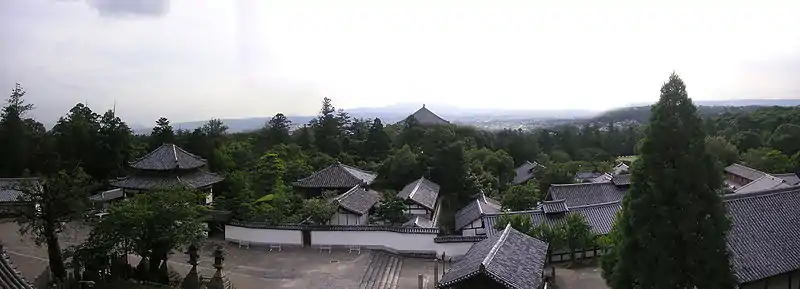Nigatsu-dō
Nigatsu-dō (Japanese: 二月堂 lit. 'The Hall of the Second Month') is one of the important structures of Tōdai-ji, a temple in Nara, Japan. Nigatsu-dō is located to the east of the Great Buddha Hall, on the hillside of Mount Wakakusa. It includes several other buildings in addition to the specific hall named Nigatsu-dō, thus comprising its own sub-complex within Tōdai-ji.[1]


History
Nigatsu-dō was founded by a monk by the name of Sanetada in 752, but the Buddhist monk Jitchu, a pupil of Rōben, later introduced a repentance service dedicated to the image of the eleven-faced Bodhisattva, Kannon in 760. It has taken place as an annual rite since 760 without any break. The service has come to be known as Shuni-e (修二会 lit. 'Second-Month Service'), as it was held in the second month of the traditional lunisolar calendar. At present, it starts on 1 March and ends on the 15th of the month.[2] Omizutori, which means taking sacred water, has become the popular name of the ceremony.
While the first Shuni-e service is said to have been held by Jichu in another temple in 752, the original construction of Nigatsu-dō hall is estimated to have completed only somewhere between 756 and 772. Nigatsu-dō was destroyed in 1667 due to a fire.[3]
- 1667 (Kanbun 7): After fire destroyed the main temple structure, work on rebuilding Nigatsu-dō (二月堂) at Nara commenced.[4]
Re-construction of Nigatsu-do is completed in 1669. In 1944, it was chosen by Japan as one of the most important cultural aspects of the country.[3]
Architecture
Although the hall was saved from civil wars in 1180 and 1567 in which the Great Buddha Hall was lost, it was burnt down during the Shuni-e service of 1667. The hall was rebuilt two years later.
The current main hall of Nigatsu-dō is a designated National Treasure. The hall holds two Kannons, a large one and a small one, although both of them are classified as Hibutsu (秘仏) – "secret Buddhas" – and therefore are not publicly shown.

Additional Images
 The east entrance to Nigatsu-dō Hall
The east entrance to Nigatsu-dō Hall Wooden stair entrance to Nigatsu-dō
Wooden stair entrance to Nigatsu-dō Nigatsu-dō winter maintenance work
Nigatsu-dō winter maintenance work View from the balcony of Nigatsu-dō
View from the balcony of Nigatsu-dō
See also
- Omizutori, the climax of Shuni-e service which takes place on 12 March every year.
- For an explanation of terms concerning Japanese Buddhism, Japanese Buddhist art, and Japanese Buddhist temple architecture, see the Glossary of Japanese Buddhism.
Notes
- "Origin of Omizutori". Gyohomiso. Retrieved 19 October 2008.
- Vrik Narayama. "Shuni-e (Ceremony of the Second Month)". Retrieved 19 October 2008.
- Nigatsu-do Hall.
- Titsingh, Isaac. (1834). Annales des empereurs du japon, p. 414.
References
Titsingh, Isaac. (1834). Annales des empereurs du Japon. Paris: Oriental Translation Fund of Great Britain and Ireland. OCLC 251800045; see also Imprimerie Royale de France, OCLC 311322353